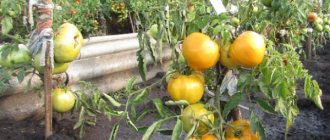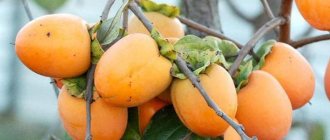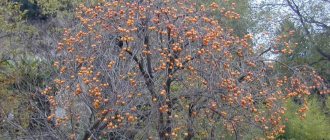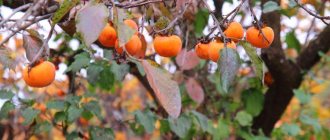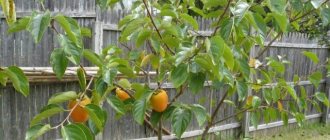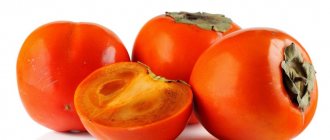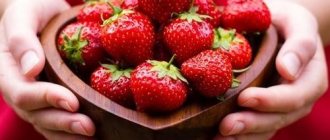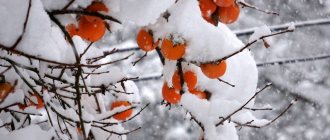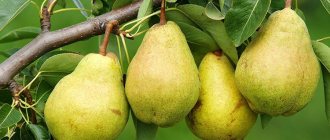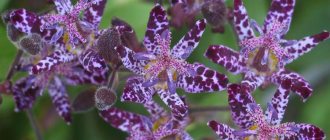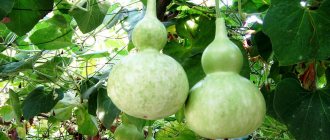Persimmon is one of my family's favorite fruits. Both children and adults adore it, not only for its honey taste, but also for its storehouse of vitamins and elements that are beneficial for the body. We usually purchase it during the winter months. The problem is that they don’t always sell exactly the variety you ask for.
Sometimes you get persimmons with a tart taste. In order to correctly determine which fruit of this plant to choose when purchasing, I decided to carefully read the information about what varieties of persimmon exist and how they differ. I want to share with you useful knowledge, supported by photos and videos.
We decided that if we master this first serious acquaintance, we will definitely try to plant this wonderful fruit tree at our dacha.
Main characteristics of persimmon
This amazing fruit came from China, translated from Greek means “food of the gods” or “divine fire”. Another meaning came from the Caucasian persimmon - “date plum”, because the dried fruit tastes like a date.
A tree or shrub lives for about 50 - 60 years, bears orange juicy fruits - berries that have from 1 to 10 seeds or without them at all. The leaves grow alternately and have a simple shape.
Because of its extraordinary taste, persimmon is widespread throughout almost all of Europe and Asia, America and Australia. Entire fruit farms are being created that supply these fruits, which have completely different taste qualities and differ in appearance.
Persimmon fruits range from bright carrot-colored to deep orange and chocolate. The viscosity disappears at the end of ripening. To remove viscosity from the fruit, persimmons are placed in a cold place or left to ripen in a warm place. Then the persimmon will have the desired jelly-like consistency.
There are about 720 species of this tree in total. Kinglets are not a separate fruit, but a type of persimmon. Has a divine sweet taste. Very popular.
The tree is grown in countries with warm climates. Along with traditional ones, there are also exotic hybrid varieties. Let's look at the most famous ones.
Use in cooking
The berries of this variety are widely used in culinary recipes. They are consumed fresh, dried and processed.
Tasty and aromatic wines and vodka are made from the pulp and peel. It makes a delicious compote.
The thick juice from the pulp is added to recipes for various dressings and sauces for meat or fish. Activated carbon is produced from the seeds of the fruit and good surrogate coffee is prepared.
Grated pulp from the fruit is added to recipes for baking sweet varieties of bread.
Classification of the main types of persimmons
There is a classification according to various characteristics and characteristics of this fruit:
The pollination method divides all varieties into several subgroups:
- Self-pollinating.
- Partially fertile.
- Self-sterile (cannot set fruit on their own without pollination).
By taste:
- Tart (the property disappears only when the fruit is fully ripe).
- Persimmon is sweet and dense in texture.
- The third variety is kings, whose taste and astringency depend directly on the pollination process.
Classification according to the timing of fruit ripening:
- Early (ready to eat in September).
- Mid-season (mid-October).
- Late (late October and until mid or late November).
Division according to the area from which the species and varieties originated:
- Eastern (or Japanese), its homeland is Asia. The trees are small, but the fruit itself is quite large - up to 500 grams.
- Caucasian (ordinary) has very small berries with a tart taste, about 2 - 3 cm in diameter, native to the Caucasus and Central Asia.
- Virginia (American) is distinguished by juicy medium-sized fruits up to 6 - 7 cm in diameter. The trees are medium in size and are resistant to cold weather.
This classification will help to most accurately determine the type and variety of fruit, and therefore the degree of its ripeness and taste.
Features of growing wild Caucasian persimmon
This tree is characterized by increased winter hardiness, so it can be grown in the climatic conditions of the Krasnodar Territory, the North Caucasus and Crimea. Persimmon grows well even on depleted lands, so it is enough for it to provide the minimum conditions:
- watering;
- rare feeding;
- well-lit area;
- not too wet soil (not in a lowland).
You can grow wild persimmons in your own garden
The yield of mature trees reaches 100 kg. Despite the small size of the fruits, they can be collected quite a lot and used for homemade preparations or sent for processing.
Planting Caucasian persimmon seedlings
Wild Caucasian persimmon can be propagated by cuttings or grown from seeds. In the first case, at the beginning of summer, take several green branches 20 cm long (with three internodes) and proceed as follows:
- Make an oblique lower and straight upper cut.
- Place overnight in a solution of “Heteroauxin” or another growth stimulator.
- Plant in fertile, moist soil with plenty of sand (deep to 3 cm).
- Cover with film or bottles.
- Water periodically.
- Two weeks after planting, liquid manure or other organic matter is added. At the same time, remove the film.
- For the winter they mulch with spruce branches, sawdust, straw and other materials.
- The following spring, Caucasian persimmon seedlings are transferred to a permanent place. The area should be illuminated, protected from winds, with light, fertile soil (although the tree grows normally on depleted soil).
Attention! The hole for planting Caucasian persimmons must be deep. Approximate dimensions – 60x60 cm.
At the bottom of the planting hole, it is necessary to fill a layer of expanded clay, broken bricks and other small stones 10–15 cm high.
Growing Caucasian persimmon from seed
You can grow Caucasian persimmon from a seed. It is planted in the fall, after the fruits ripen. You need to act this way:
- Remove the seed from the fruit and rinse it thoroughly to remove any remaining pulp.
- Place for several hours in a solution of “Heteroauxin” or another growth stimulator.
- Plant in a pot with fertile, loose soil.
- Cover with film and place in a warm, shaded place.
- Water periodically using a spray bottle.
- Two weeks after the sprouts appear, dig up the seed and carefully remove the shell.
- Transplant into open ground in the spring, when there is no frost.
Popular persimmon varieties
Let's consider those types that we can freely purchase in the store and are the most famous in terms of taste.
Chocolate Wren
Also called "chocolate persimmon", "chocolate pudding" and Hyakume. Now it grows in the southern regions of Russia, Ukraine, the Caucasus, Central Asia and South Africa.
Brief description of the variety:
- The tree belongs to the ebony genus.
- It has one feature that distinguishes it from all other types of persimmon. If the kinglet has passed the pollination stage, then the fruits will have seeds and will be dark orange in color, with a rich and sweet taste, and if pollination has not occurred, then the color will be light with a reddish tint, and the flesh will taste viscous.
- The fruit has an orange skin and dark chocolate pulp. The riper the fruit, the darker its contents. The big plus is that it never gets stuck. And if it’s not quite ripe, then it’s simply firmer in structure and not as sweet. The weight of one fruit reaches the size of a large apple.
- The tree begins to bloom in May. In early July, the ovary forms and the fruits ripen and gain juiciness until October. That's when it's time to harvest. The pulp should already be dark chocolate and creamy. The shape of the king is round or slightly flattened and heart-shaped. This indicates complete maturity.
This variety is low in calories (only 53 kcal per 100 g) and is ideal for sweet lovers and those on a diet. Wren contains a lot of useful substances: vitamin A and C, potassium, magnesium, iron, pectin, phosphorus and calcium.
Honey Wren Early
Fruits before the chocolate king. It does not have such dark flesh, on the contrary, it is light in color. It is also a very sweet and tasty fruit.
The pulp is tender and softer in consistency. It’s not for nothing that this variety is called honey, because the taste is really so unusual and with notes of honey. The variety is considered early.
Large persimmon, king type
The variety is similar to the chocolate king, only its flesh is not brown-chocolate in color, it is red-orange. The fruits are larger than other species of this variety. Has a slightly nutty taste. An unusually original and healthy fruit and divinely tasty.
When the fruit is not quite ripe, it becomes a little sticky. This deficiency completely disappears when the persimmon is fully ripened.
Fig persimmon
One of the most famous varieties. The name is given based on the similarity with the oriental fruit - figs.
Description and characteristics of this variety:
The earliest variety. Also called Chamomile or Fuyu unpollinated, seedless. It goes on sale at the beginning of winter.
Contraindications for use
Wild persimmon contains the astringent substance tannin, so it should be used with extreme caution by anyone who has gastritis, peptic ulcers of the stomach or intestines. Doctors do not advise patients to eat such a product after surgery on these organs.
For those who experience a burning sensation in the epigastric region after eating the fruit, the exotic fruit should be excluded from the diet.
Wild persimmon is contraindicated:
- for constipation (tannin has a binding effect and can cause the development of hemorrhoids);
- for diabetes mellitus, because The pulp contains large quantities of fructose and sucrose.
Small fruits grow densely on the branches
Description of persimmon varieties
The plant is systematized by species depending on the region of growth. It is most widespread in the Indomalayan subtropical zone, covering a vast territory from East and Southeast Asia, including Australia and India. Of the 1,500 species, 725 varieties are described, the most famous and used by humans. For example, persimmon:
- low;
- black;
- opposite leaf;
- Hawaiian;
- eastern (Japan and China);
- Caucasian;
- Virginia;
- Sharon (Israel);
- multi-colored;
- Ceylon (ebony);
- loquat (African);
- Mexican;
- Peruvian.
Some popular varieties among sellers have a common name - kinglet.
Nikitskaya burgundy persimmon: variety description
The plant belongs to the constant, mid-season varieties. The berries are round-flat, weighing from 50 to 150 g. The color of the fruit is reddish-burgundy, the taste is sweet.
Russian persimmon variety
“Rossiyanka” bears fruit every year. The fruits appear on a tree of small height. Its originality lies in the fact that it forms only female inflorescences. Pollination is not necessary for fruiting. The berries are yellow with an orange tint. Up to 80 kg of harvest is harvested from one tree at the end of autumn. Each fruit weighs about 100 g.
The berries are picked from the tree when they are still firm and tart in taste. Ripening occurs during storage. Ripe fruit contains an increased amount of fructose and has an original aroma. Small trees are planted in the ground in spring and autumn. The main thing in describing the characteristics of the Rossiyanka persimmon variety is the ability of the tree to withstand temperatures as low as -35°C.
Look at the photo of the “Rossiyanka” persimmon variety:
The beneficial properties of the plant are associated with the content of a large amount of β-carotene, a precursor of micronutrient A, the distinctive feature of which is its orange color, like carrots. Eating persimmon helps improve immune defense and resist cancer. A significant content of the microelement Fe improves hematopoietic reactions, and vitamin C helps cope with colds.
Persimmon variety "Virginskaya"
The tree has taken root well in the southern regions of Russia - Krasnodar Territory, Volgograd Region, and the Caucasus. Near Sochi it blooms until mid-June and manages to produce ripe fruits. To get a good harvest from a medium-sized tree (up to 10 m), you need to shape the crown. Fruit ripening does not occur simultaneously, but is extended from mid-October to mid-December. The weight of one berry is from 30 to 45 g. The taste of the fruit is sweet, the quality is better than oriental persimmon, the amount of sugars is twice as much.
The pest for the tree is the Japanese false scale insect, and the most dangerous disease is gray rot. It affects flowers, ovaries, berries and even young shoots. They get rid of it by treating with Bordeaux mixture in April, before and after flowering. The tree is protected from larvae and adult false scale insects with special means.
Persimmon virginia large-fruited
A hybrid of Virginia persimmon native to America. Tree of medium height. Very frost-resistant. Withstands frosts down to -37°C. Tolerates dry periods well. It resists pests and diseases independently. The fruit ripens in October. The berries are medium in size and weight - up to 70 g. The peel is yellow-brown, and the flesh is darker with a marmalade texture. It is stored for a long time and ripens during storage.
Caring for Caucasian persimmon
This plant does not require care, so the cultivation technology is quite simple. Young seedlings are watered weekly, and in drought conditions - twice a week. Mature trees are moistened only in hot weather, giving 2-3 buckets. After watering, the tree trunk circle is dug up, and weeding is carried out if necessary.
Even with minimal care, an adult tree produces up to 100 kg of fruit
If the soil is fertile, you do not need to apply fertilizer in the first four years after planting. Then they are given three times per season - in the spring, urea or ammonium nitrate (15–20 g per tree), during flowering and at the fruiting stage - superphosphate (40 g) and potassium sulfate (30 g).
Another mandatory activity is pruning. It is carried out in early spring and late autumn. Remove dried, diseased, old, non-fruiting branches, and also form a crown. The plant is resistant to insects and other pests, so it is not necessary to treat it with drugs.
Attention! For the winter, it is recommended to mulch the tree trunk circle with dry grass, leaves, branches, sawdust, peat, and humus.
Title [edit | edit code]
The Latin name of the genus, Diospyros, is of Greek origin and can be translated as “food of the gods”, another meaning is “divine fire”.
The word “persimmon” came into Russian from Farsi, where in the original it sounds like خرمالو khormâlu
- that is, date plum.
The word خرما khormâ
means date, the word آلو
âlu
means plum.
The name khormâlu
originally referred to the Caucasian persimmon. Dried persimmon tastes very much like dates, hence the name Caucasian persimmon in Farsi. Then this name spread to other types of persimmon, including the oriental (Japanese).
Species with edible fruits can be called: “wild date”, “date plum”.
Does Caucasian persimmon knit?
Caucasian wild persimmon, like cultivated varieties, contains tannins (tannins). Therefore, they knit noticeably, especially when unripe. However, freezing or drying destroys these components, resulting in improved flavor. Sweet tones and slight sourness are noticeable.
The fruits are edible. They are used both fresh and frozen or dried. Non-alcoholic drinks and tinctures are prepared from them and used for baking. The leaves of wild Caucasian persimmon are used in tea, and an analogue of coffee is prepared from the seeds.
Botanical description [edit | edit code ]
Trees or shrubs, deciduous or evergreen. There are no terminal buds. The leaves are simple, alternate, sometimes with small translucent glands. Flowers are dioecious or polygamous. Male flowers are axillary, usually collected in racemes. Stamens from 4 to many, often paired. Female flowers are usually solitary, axillary. The calyx is usually 3-5 (sometimes up to 7) petaled, and can be reduced. The corolla is bell-shaped or tubular, 3-5 (-7) lobed. The fruit is a fleshy, leathery berry, usually with a large calyx. Seeds from 1 to 10 or more, often compressed on the sides. [3]
Useful properties of persimmon
The berries are low in calories - 100 g of product contains only 53 kcal.
Their benefits are as follows:
- ascorbic acid, which is contained in the pulp, increases the body’s immunity and resistance to many viral and bacterial infections;
- tannin normalizes the functioning of the stomach and intestines, and also accelerates metabolic processes;
- iron improves hematopoietic function, increases hemoglobin and prevents the development of anemia;
- carotene has a beneficial effect on the functioning of all internal systems, and also increases their activity in the fight against many diseases;
- the fruits of this tree have a wound-healing and expectorant effect;
- Vitamin A improves vision, prevents the development of cancer, and prevents premature aging of cells.
Fruits [edit | edit code]
Use of fruits [edit | edit code]
Unripe persimmon fruits have an astringent taste and can cause gastrointestinal disorders.
Despite the relatively high sugar content, persimmon does not contribute to a sharp increase in blood sugar (it has a low glycemic index) and contains only 62 kcal per 100 g of product. The bright orange color of persimmons indicates that they have a high content of beta-carotene and bioflavonoids. Ripe persimmon contains (from the daily intake): 25% sugars, 1.5% protein, 0.85% fat, up to 55% vitamin C, tannins, various microelements, including iodine, iron, magnesium, potassium.
Therefore, persimmon is recommended for use by patients with diseases of the cardiovascular system, hypertension, and anemia. In the Caucasus, persimmon is eaten in large quantities for early forms of toxic goiter. In China and Japan, persimmon is used to treat atherosclerosis, and its juice treats scurvy; in Thailand, intestinal worms are expelled; in Korea, persimmon is considered an anti-inflammatory agent and is used in the treatment of dysentery, enterocolitis and bronchitis. The effectiveness of a diet rich in persimmon in normalizing lipid metabolism is confirmed by scientific research [7]. Persimmon fruits have a beneficial effect on the condition of the liver and bile ducts.
Persimmon has a pronounced diuretic effect.
Persimmon pulp has bactericidal properties, so the inclusion of persimmons in the diet during epidemics contributes to general treatment. In some countries, persimmons cut in half are applied to burns and wounds. Persimmon is useful for exhaustion (both nervous and physical). Enuresis is treated with a decoction of the hard “tails” of the fruit.
Traditional medicine uses, in addition to the fruits, persimmon leaves. Dried persimmon leaves are considered biologically active, so tea made from them is useful for older people, as well as for people with anemia. Steamed leaves are applied to festering wounds and abscesses.
Persimmon fruits can be eaten fresh, dried, made into jams, desserts, cider, molasses, wine, beer and moonshine.
Roasted and crushed Virginia persimmon seeds were used by Confederate soldiers and Southern states during the American Civil War as a coffee substitute [8].
Contraindications [edit | edit code ]
Due to the high tannin content, persimmons should not be consumed during the postoperative period (abdominal organs), as well as by people who have developed adhesive intestinal disease due to abdominal surgery. Excessive consumption of persimmons, especially unripe fruits, which have the highest content of tannin and plant fibers, can lead to acute intestinal obstruction due to the formation of phytobezoar and urgent surgery [9] [10].
Description and characteristics
Wild Caucasian persimmon is the smallest variety, resembling grapes or cherries in appearance and size of the fruit; it belongs to the Ebony family, Persimmon species.
Botanical description and appearance with photo
The tree is 15 to 30 cm high and 40 to 45 cm in diameter, has glossy oblong leaves with pointed ends, 5 to 15 cm long, and 3 to 6 cm wide. On old trunks, the bark often crumbles, the tree has no small branches, it has massive roots that help it stay on almost any surface (coast, mountain slopes). It has small light green flowers that appear in the first summer months of June and July.
The fruits are small in size, resembling the shape of a ball with a diameter of 1-2 cm . Small berries are usually yellow or dark red, and overripe ones have a thin layer of waxy coating and turn brownish-black. The seeds have a thin skin and hard endosperm. The ripening period usually ends in late autumn - in November.
Read more about the photo of persimmon: tree and fruit.
Spreading
This plant is subtropical, its range extends from Japan through Northern India and China to the western Mediterranean, all the way to Spain, and can also be found in:
- North Africa;
- USA;
- Azerbaijan;
- Central Asia;
- Mexico;
- Crimea;
- Guatemala;
- Philippines;
- on Sulawesi and the Moluccas Islands;
- in the Caucasus.
Breeding
To this day, breeders argue about the origin of this tree. Some are of the opinion that the tree originally grew in Japan, then it was brought to China and continued its “journey” to eastern countries. Others claim that the plant immediately appeared in the forests of the Caucasus and from there began its spread throughout the world. There is no consensus on the origin.
Do the fruits knit?
Important!
Due to the tannin content, which provides an astringent effect in ripening fruits, a specific sensation is created in the mouth.
Only completely ripe persimmon is not astringent, but at the same time sweet and tender.
To avoid stickiness in the mouth, persimmons can be frozen, dried, or wilted . Dried fruits do not create an astringent effect, but when moisture is returned, the tart, not the most pleasant taste may return.
Conditions for normal growth and development of persimmon
The usefulness and pleasant taste of the fruits is the main reason for breeding this amazing tree.
An important factor that attracts gardeners is its fertility. Since each adult plant can harvest approximately 200 kg of fruit annually.
Today, you can increasingly find it in the gardens of Caucasian residents. Due to the small size of the fruit and its “forest” origin, Caucasian persimmon is popularly called wild.
Necessary conditions for the normal growth and development of this tree:
- the soil should be well moistened, so experienced gardeners recommend watering at least 1-2 times a week during the hot summer;
- Persimmons have no special requirements for the composition of the soil; they can also grow on rocky surfaces;
- quite frost-resistant, in winter it normally “survives” frosts up to 20 degrees, but during the spring thaw, significant temperature fluctuations can adversely affect bud growth;
- the plant is not prone to disease and is not damaged by insect pests, so there is no need to spray or treat it with chemicals.
Uncomplicated growing conditions make Caucasian persimmon one of the most popular plants in Central Asia.
How to choose
To choose the right black sapota, you need to focus on the color of the peel and the smell. Ripe fruits have a weak fruity aroma and a muted green tint. There may be specks and dots on the skin, but there should be no dents or brown spots. A ripe berry is soft to the touch and is easy to press, so you need to touch it carefully. To some, the brown color of the interior seems unpresentable. Overripe fruits may be bruised, which spoils their appearance. However, this does not affect the taste in any way.
Black Dagestan persimmon: benefits
Black Dagestan persimmon, also called black sapote, has many beneficial properties. Regardless of its low calorie content, the product is nutritious due to the large amount of sugar it contains in the form of fructose, sucrose and glucose. The fruits contain a lot of vitamins B, C, phosphorus, calcium and iron.
Due to the content of beneficial microelements and vitamins, the fruit creates a powerful general strengthening effect on the body and is suitable for the treatment and prevention of vascular and heart diseases, as well as respiratory viral infections. Some actively use black persimmon in the fight against extra pounds. Its regular consumption strengthens teeth and bones, increases the concentration of hemoglobin in the blood and strengthens the immune defense.
Not only the small black persimmon is useful, but also its leaves. From them you can make a healing decoction that creates a fixing, astringent and antipyretic effect on the body.
Finding black Dagestan persimmon in supermarkets is not easy, but it is found quite often on the market, and is not as expensive as you might imagine.
Nutritional value, composition and calorie content of persimmon
Persimmons are low in calories but rich in fiber, vitamin A, manganese and vitamin C.
100 grams of raw oriental persimmon contains (% of the recommended daily intake) (1):
- Calorie content: 70 kcal (3%).
- Carbohydrates: 18.6 g (6%).
- Fat: 0.2 g (0%).
- Protein: 0.6 g (1%).
- Fiber: 3.6 g (14%).
- Vitamin A: 1627 IU (33%).
- Vitamin C: 7.5 mg (13%).
- Vitamin E: 0.7 mg (4%).
- Vitamin B6: 0.1 mg (5%).
- Potassium: 161 mg (5%).
- Copper: 0.1 mg (6%).
- Manganese: 0.4 mg (18%).
- Omega-3 fatty acids: 4 mg.
- Omega-6 fatty acids: 39 mg.
Persimmons also contain trace amounts of vitamins, minerals and nutrients such as vitamin K, thiamine, riboflavin, niacin, folic acid, choline, calcium, iron, magnesium and selenium.

